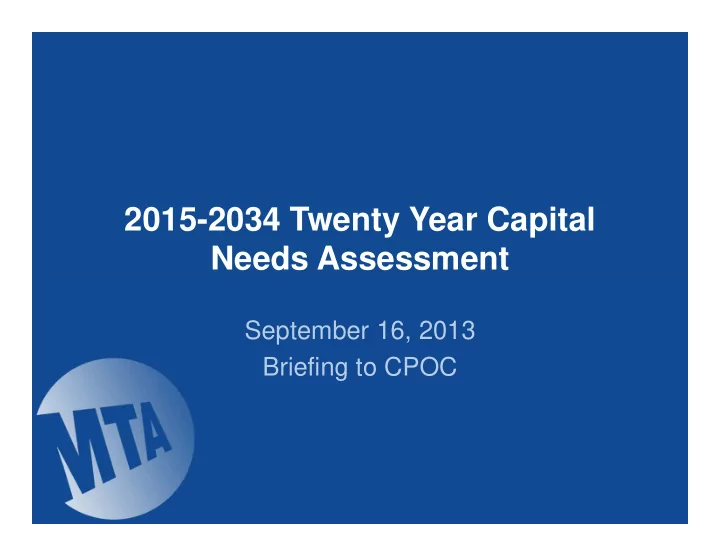

2015-2034 Twenty Year Capital Needs Assessment September 16, 2013 Briefing to CPOC
Wide Range of MTA Assets • 350 power substations • 1,322 miles of 3 rd rail • 291 pump rooms, etc… 1
Assets Require Cyclical Investments Acquire Operate Renew or or and Build Maintain Replace 2
Evolution of MTA Capital Investment Expand Improve Renew Stabilize 100% Expansion Investment Split 80% System Improvement 60% 40% State of Good Repair / Normal Replacement 20% 0% ’82-’91 ’92-’99 ’00-’04 ’05-’09 ’10-’14 ’15-’19 Asset Management 3
Twenty Year Needs (TYN) Overview • Long-standing MTA capital planning exercise originated in ’80s • Provides strategic roadmap for capital investments in 2015-2034 period; precursor to 2015-2019 Capital Plan • Provides consistent, MTA-wide framework for prioritizing needs • Underpins ongoing efforts to achieve and sustain State of Good Repair 2015-2034 Twenty Year Needs 2015-2019 Five Year Plan Asset Inventory and Condition Assessment 2015-2034 2015-2019 Investment Program of Strategies / Needs Projects Strategic Vision 4
Current Twenty Year Needs Process • Agencies undertake assessment of each asset based on location, age, condition, performance, safety, and reliability • Identifies: – Significant investments needed to bring assets to SGR Core Needs Assessment – Normal replacement investments needed to maintain reliability of assets already in SGR • Results inform prioritized investment needs, subject to a series of constraints • Operational capacity to schedule work and maintain service • Ability of consulting and contracting market to absorb work Constraints • Availability of MTA resources to support project delivery • Funding limitations 5
Impact of Sandy on Capital Planning • Superstorm Sandy resulted in damage to select priority portions of system already in SGR (e.g., under river tunnels) • Recovery and initial resiliency needs are being addressed in 2010-2014 Plan – Recovery investments are predominantly special out-of phase replacements to restore pre-Sandy SGR – Resiliency investments will harden MTA system against future disruptions • Future projects will incorporate new resiliency standards to minimize impacts of climate events 6
Key 2015-2034 Investment Categories • Signals & Comms (19%) • Bus & Rail Rolling Stock (18%) Major Investment • Track & Structures (15%) Categories • Stations (12%) • Customer Information Emerging • New Fare Payment Priorities • Resiliency 7
2015-2034 Core Needs (2012 $) 2015-2019 $26.6 b (25%) 2020-2024 25.6 (24%) MTA-Wide Needs per 2025-2029 28.6 (27%) 5-Year Period 2030-2034 24.9 (24%) Total $105.7 b (100%) NYCT $68.2 b (65%) LIRR 13.4 (13%) MNR 8.9 (8%) Total Needs MTABC 2.5 (2%) by Agency B&T 12.0 (11%) PD/Security 0.6 (1%) All MTA $105.7 b (100%) 8 Note: Numbers may not total due to rounding
2015-2034 NYCT Core: $68.2 b (2012 $) Modernize interlockings and expand CBTC Real-time information infrastructure Fleet normal replacement Continue station component strategy Times Square and Grand Central circulation improvements Contactless fare collection to replace MetroCard 27% Continue track component strategy 21% Rockaway Line improvements 14% New structures component strategy 8% 7% 7% 5% 5% 4% 2% Signals/ Cars/ Stations Track Shops/ Line Traction Line Major Other Comms Buses Yards/ Equip. Power Struct. Improv. Depots 9
2015-2034 LIRR Core: $13.4 b (2012 $) Complete Double Track and Jamaica Capacity Improvements Replace aging fleets: M3 EMUs, locomotives, coaches Station component rehabilitations, including ADA accessibility and fare collection technology Parking expansions and intermodal facilities Power components and expanded electrification 25% Heavy signal replacement & finish PTC 17% 15% 14% Achieve line structures SGR 11% 8% 6% 4% Track Rolling Stations Power Comms/ Line Miscell. Shops/ Stock Signals Struct. Yards 10
2015-2034 MNR: $8.9 b (2012 $) Continued SGR and NR investments Replace fleets on NR cycle: M3 EMUs, locomotives, coaches Continued NR cycles in station components. Customer communications and fare collection technology improvements. Strategic intermodal facilities and Transit Oriented Development Complete Harmon Shop Replacement 26% Heavy signal replacement & finish PTC 23% NR of traction power Trainshed / tunnel 13% rehab. 10% 9% 8% 7% 5% Track/ Rolling Stations/ Shops/ Comms/ Power GCT Miscell. Struct. Stock Parking Yards Signals 11
2015-2034 MTA Bus: $2.5 b (2012 $) Fleet normal replacement Component-based depot improvements Expanded share of articulated buses 34% 24% Radio system / farebox upgrades 14% 12% 12% 4% Express Buses Standard Depots Articulated Radio/Systems Other Buses Buses 12
2015-2034 B&T Core: $12.0 b (2012 $) Bronx-Whitestone Bridge / Verrazano Narrows Bridge main cable replacement/rehab Throgs Neck Bridge approach viaducts replacement Ongoing tunnel rehabilitation work Rockaway Crossings rehabilitation / reconstruction Verrazano Bridge lower deck repl. & Belt Parkway ramps reconstruction Throgs Neck Bridge CI Pkwy ramp & suspended span deck replacement Bronx-Whitestone Bridge Queens interchange reconstruction 46% Bridge condition monitoring systems Electrical and mechanical systems rehabilitation Fire suppression systems Verrazano Bridge W/B toll plaza reconstruction 18% Toll collection system rehabilitation 13% 9% 7% 5% 2% Structures Roadways/ Utilities Painting Toll Plazas Buildings/ Miscell. Decks Sites 13
Next Steps: Strategies for 15-19 Plan • Asset life maximization: enable assets to provide longer service life between capital investments • Component replacement: focus on targeted replacement of asset components with critical needs • Fleet plan updates: embrace new ridership trends, technologies, and standards to improve customer benefits and reduce costs • Track access optimization: reduce the cost and maximize the capacity for replacing and renewing track, signals, etc. • Enterprise asset management: coordinate capital and operating interventions to reduce life-cycle costs, improve performance, and maximize investments • Analytical review of proposed projects: validate that investments are carefully planned to maximize benefits at minimal cost • MTA-wide coordination: ensure aligned investments in strategic areas such as new fare payment and asset management software 14
Moving Forward • Develop 2015-2019 Plan: rationalize 2015-2019 needs into actionable program of projects, which – Prioritize and address critical needs: identify strategies to keep other assets fit for purpose – Reduce costs and maximize benefits September 2013 2015-2019 Plan development April - May 2014 Compile draft 2015-2019 Plan book July 2014 Stakeholder briefings August 2014 Complete 2015-2019 Plan book September 2014 Submit Plan to MTA Board for approval October 2014 Submit Plan to CPRB for approval 15
Recommend
More recommend